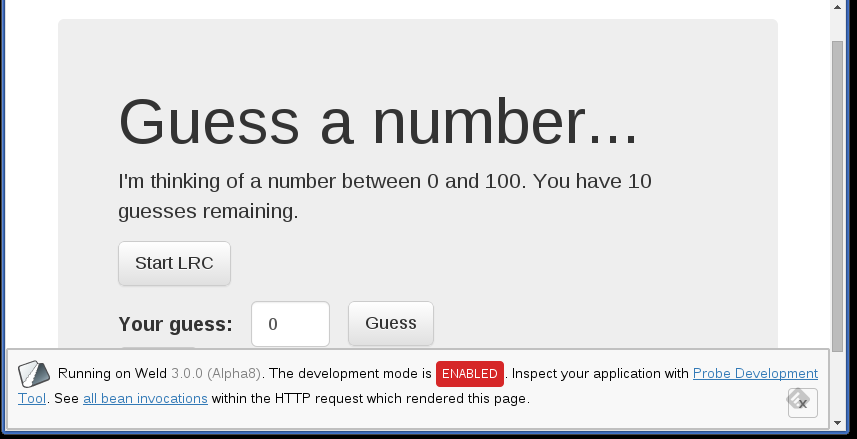Weld 3.0.0.Alpha16
The next experimental Weld version has been released! See also the release details. Thanks to everyone involved in this release!
This release includes a lot of bugfixes and improvements (e.g. all the notable tasks implemented in the latest stable version: Weld 2.3.4.Final). However, the main goal of this release is to align with CDI API 2.0.Alpha4, and in particular to implement the current version of "metadata builders" API (CDI-558). So that everyone can play with the API, discover possibilities and find potential issues. Note that this release also introduces a non-standard experimental feature: Weld SE synthetic container lifecycle event observers. So it should be even easier to get started - no extension class is needed in Weld SE.
Metadata configurators - basic ideas
Note that we don’t use the term "builder" because there is no build() method in the API.
Also note that the API is not intended to cover every possible case.
Instead, we would like to help with common tasks.
And if necessary, an extension developer can always use the original replacement methods for more complicated stuff.
IMPORTANT POINTS:
-
an extension developer receives a configurator instance from a container lifecycle event
-
a configurator instance is always automatically processed at the end of the observer invocation
-
for bean discovery events (all events starting with
Process):-
configureX()methods return the same configurator instance (for the given observer method invocation) -
the configurator is initialized/preconfigured with the component being processed, e.g.
ProcessAnnotatedType.configureAnnotatedType()returns a configurator initialized withProcessAnnotatedType.getAnnotatedType() -
the result of the configurator will automatically replace the original component (e.g.
AnnotatedTypein case ofProcessAnnotatedType) -
replacement methods (e.g.
ProcessAnnotatedType.setAnnotatedType()) should not be used together with configurators (CDI-596)
-
-
for application lifecycle events (e.g.
AfterBeanDiscovery):-
addX()methods always return a new configurator instance -
the configurator is always uninitialized/empty, but we should probably define some default values wherever it makes sense (e.g.
Receptionfor observer methods) -
the result of the configurator will be automatically added (e.g.
Beanin case ofAfterBeanDiscovery.addBean())
-
We have prepared some simple examples - see below. More advanced examples can be found in the TCK test cases. And as usual - feel free to add comments to this blog post. Any feedback is appreciated!
BeforeBeanDiscovery example
@Singleton
class MyService {
// This class is not placed in a bean archive
}
class MyExtension implements Extension {
void beforeBeanDiscovery(@Observes BeforeBeanDiscovery event) {
// Add MyService to the set of discovered classes and replace @Singleton with @ApplicationScoped
event.addAnnotatedType(MyService.class.getName(), MyService.class)
.remove(Singleton.class)
.add(ApplicationScoped.Literal.INSTANCE);
}
}ProcessAnnotatedType example
class MyExtension implements Extension {
void processAnnotatedType(@Observes @WithAnnotations({ Observes.class, ObservesAsync.class }) ProcessAnnotatedType<?> event) {
// Add interceptor binding to all methods annotated with @Observes or @ObservesAsync
event.configureAnnotatedType()
.filterMethods(MyExtension::isObserver)
.forEach(methodConfigurator -> methodConfigurator.add(Monitored.Literal.INSTANCE))
}
static boolean isObserver(AnnotatedMethod<?> annotatedMethod) {
return annotatedMethod.isAnnotationPresent(Observes.class) || annotatedMethod.isAnnotationPresent(ObservesAsync.class);
}
}ProcessBeanAttributes example
class MyExtension implements Extension {
void processBeanAttributes(@Observes ProcessBeanAttributes<?> event) {
// For all beans remove the IllegalBeanType from the set of bean types
if (event.getBeanAttributes().getTypes().contains(IllegalBeanType.class)) {
Set<Type> legalTypes = new HashSet(event.getBeanAttributes().getTypes());
legalTypes.remove(IllegalBeanType.class);
event.configureBeanAttributes().types(legalTypes);
}
}
}AfterBeanDiscovery example
class MyExtension implements Extension {
void afterBeanDiscovery(@Observes AfterBeanDiscovery event) {
// Add a new synthetic observer method - no need to use the fluent API
ObserverMethodConfigurator<Foo> configurator = event.<Foo>addObserverMethod();
configurator.observedType(Foo.class);
configurator.reception(Reception.ALWAYS);
configurator.transactionPhase(TransactionPhase.IN_PROGRESS);
configurator.notifyWith((foo) -> System.out.println("Foo observed: " + foo));
// Add dependent bean - Integer between 0 and 999
event.addBean().addType(Integer.class).addQualifier(Random.Literal.INSTANCE)
.produceWith(() -> new java.util.Random().nextInt(1000))
}
}WildFly Patch
As usual, a patch for WildFly is available. This time the target platform is WildFly 10.0.0.Final. If you’re not familiar with patching WildFly, check Markus’s tutorial.
[ Download ] [ Documentation ] [ Release notes ]



